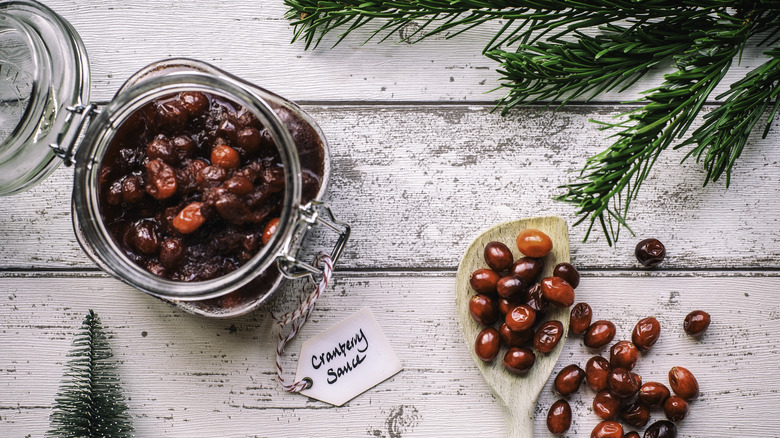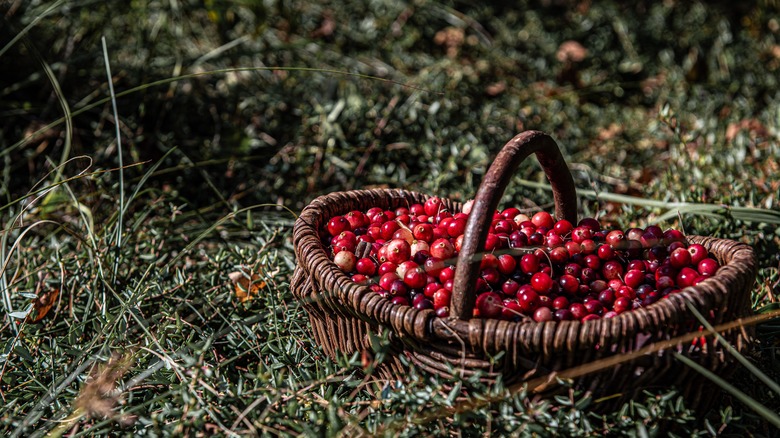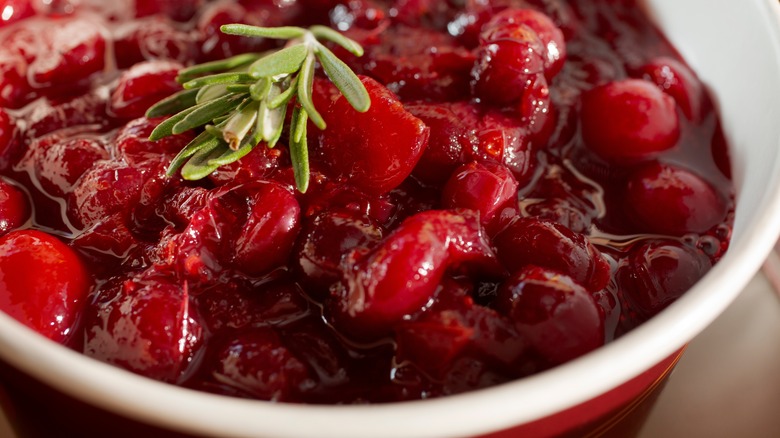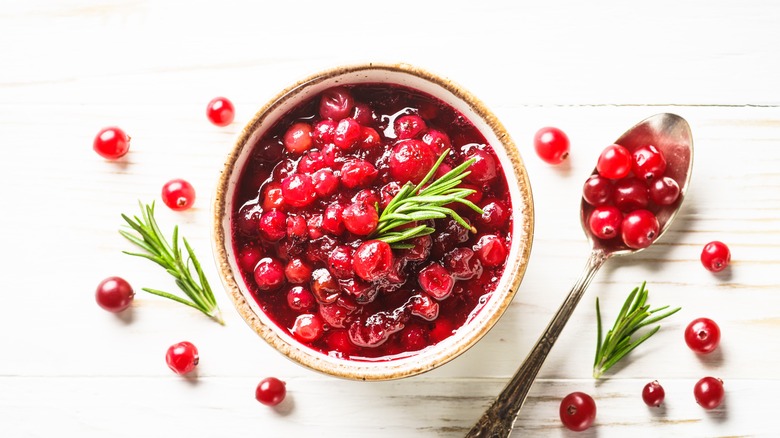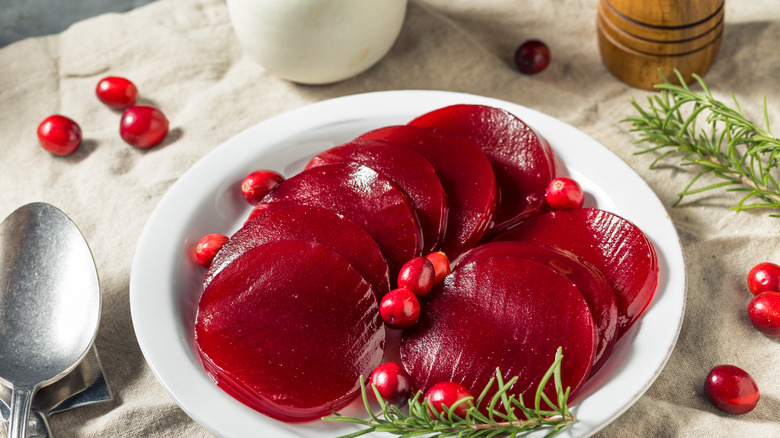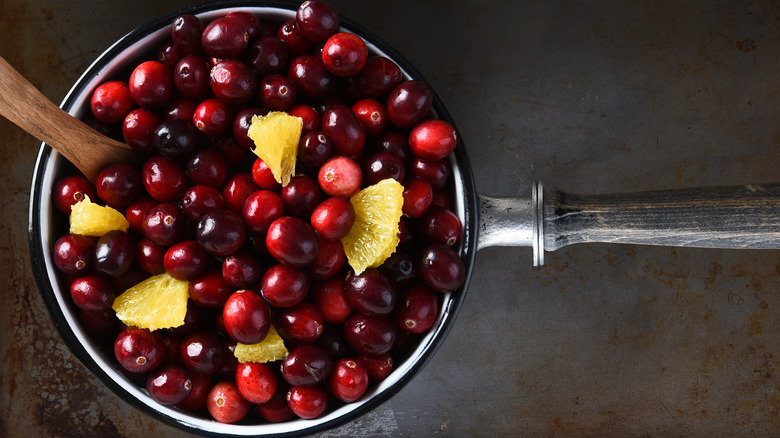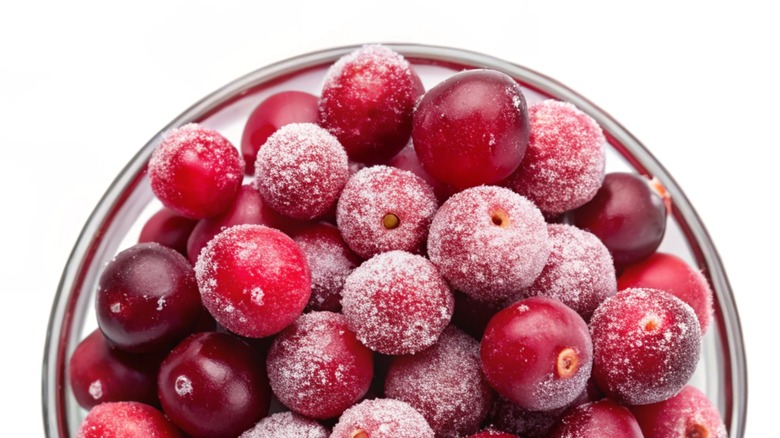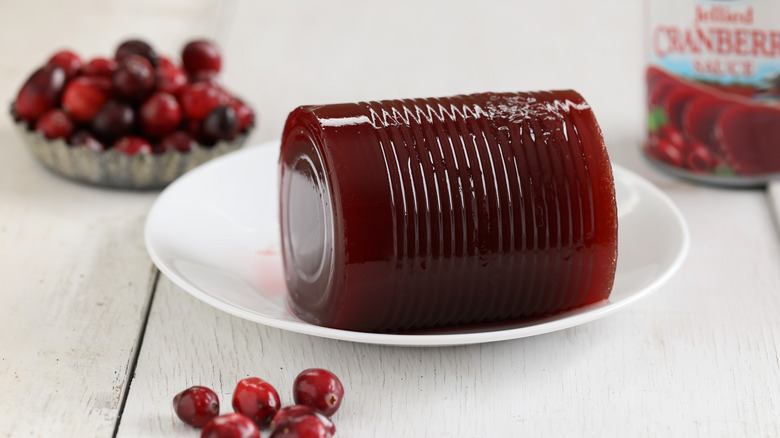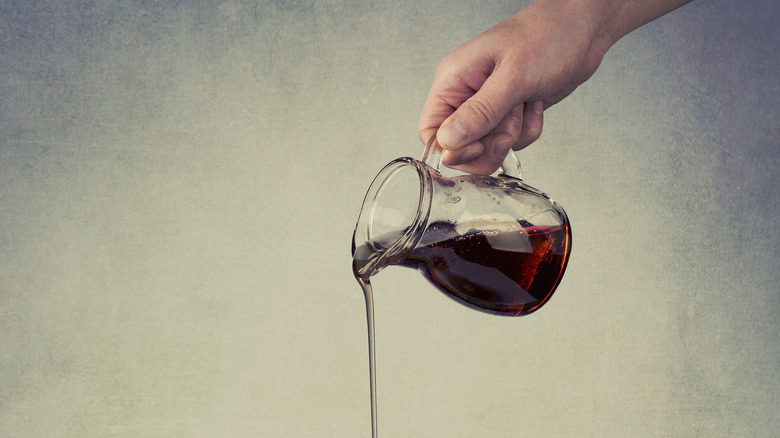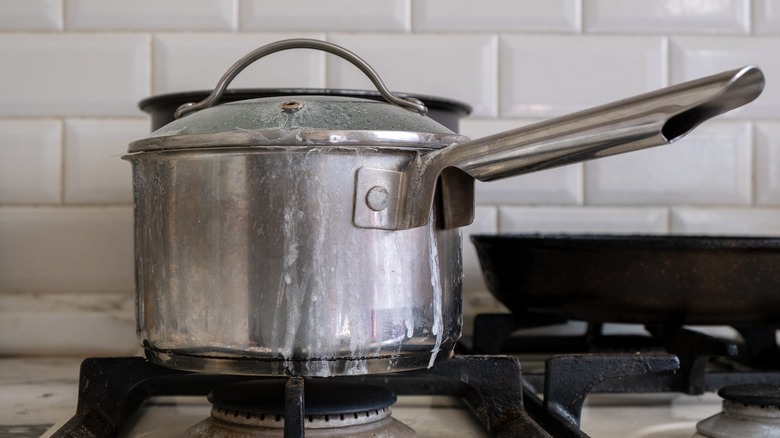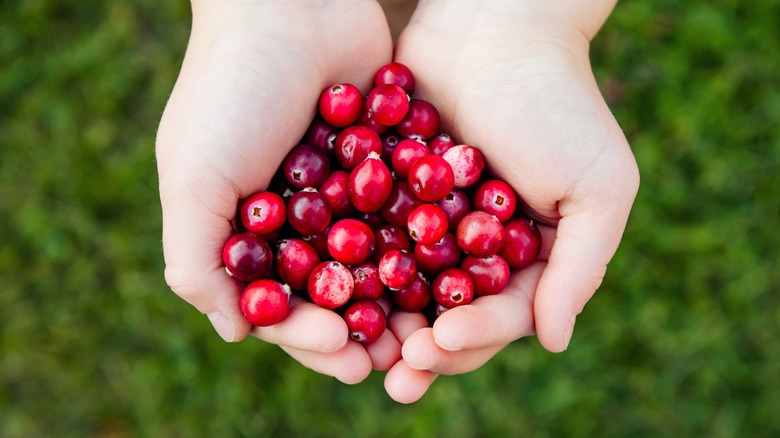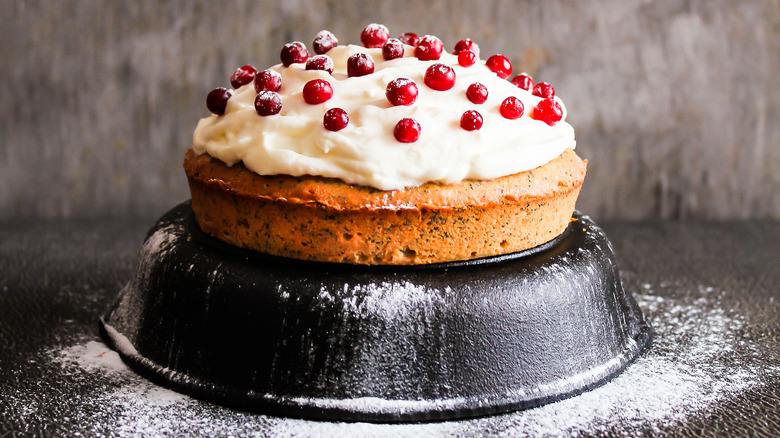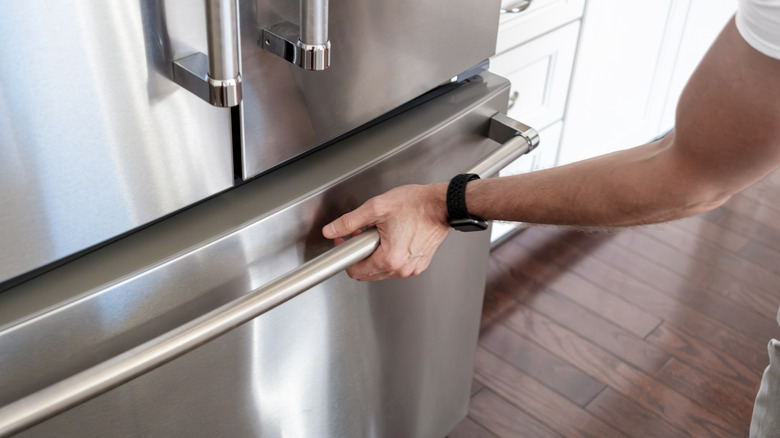12 Things You Didn't Know About Cranberry Sauce
We may receive a commission on purchases made from links.
Cranberry sauce is a holiday must. Whether you make turkey dinner only in November or recreate the spread for the winter holidays as well, the tart flavor of cranberry perfectly accompanies meat, sandwiches, and more. It's also an important ingredient for Indigenous Peoples Day, so it has evergreen potential for much of fall and winter. Plus, it's just plain delicious on a sandwich or a piece of chicken. Add in all those purported health benefits, and you can't go wrong.
But do you really know the humble cranberry as well as you think you do? Between its growing habits and storied past, its many variations, and the number of mistakes you can make with it (spoiler alert: there are a lot of them), you may not know it as well as you think you do. The good news is that you soon will. Grab your cranberry cocktail, a handful of raisins, and a comfortable seat. It's learnin' time.
Cranberries are a true berry
Just because it's called a berry doesn't mean it's actually a berry. For example, look at the strawberry, which is actually a pseudocarp or false fruit. The tricksy strawberry is actually lots of tiny fruits all grown together into a big fleshy mass. (Side note: gross.)
On the other hand, cranberries (Vaccinium macrocarpon) are a true berry. "This means they develop from a single ovary of a flower, forming a simple, fleshy fruit," explains Jennifer Pallian of Foodess. "Cranberries belong to the Ericaceae family, which includes other true berries like blueberries, making them genuine botanical berries by structure." In other words, unlike the duplicitous strawberry, they can be trusted.
Less trustworthy? Their growing conditions. For one thing, they don't actually grow in water like people think. Rather, marshy bogs are flooded during harvest time to float the cranberries, which makes them easier to gather. For another, you might want to rethink hanging around in cranberry bogs: Humans are only one of their common denizens, another being bog spiders. Yes, you read that right. Bog spiders. It is not any more pleasant than it sounds.
Turns out cranberries are great at gelling
There's a reason that cranberries make for such a lusciously thick sauce. "Cranberries naturally contain a significant amount of pectin, a polysaccharide that acts as a gelling agent," Jennifer Pallian says. "Pectin, found in plant cell walls, forms a network that traps sugar molecules when cooked, creating a gel-like consistency. The naturally low pH of cranberries activates the pectin molecules, enhancing gel formation." Thus, their acidity also works in their favor.
Sometimes, though, cranberry sauce needs a little help. If you want to make a super firm sauce that you could slice (à la the canned variety), then you'll need to enlist some additional pectin to help it gel. The more you add, the more it will thicken and hold its shape, so it stands tall on a spoon when you scoop it rather than dissolving into a pile of mush. If you like, though, you can make a sauce that contains only cranberries and sugar, which will thicken nicely for spooning over turkey.
Cranberry sauce is an invention for the ages
Although many white Americans think of cranberry sauce as a time-honored European tradition, the berries were first cultivated and honored by indigenous peoples in North America. Indeed, before it ever sat alongside Brussels sprouts and mashed potatoes, it was grown, harvested, and celebrated by the Aquinnah Wampanoag and others. For that reason, it has a solid place at the table for Indigenous Peoples' Day.
Its history didn't end there, though. We have an American businessman to thank for the current ubiquity of cranberry sauce at the holiday table. Marcus L. Urann, a lawyer-turned-cranberry-bog-owner, figured that he could extend the six-week cranberry season considerably if he learned to can it, and boy, was he right. Now you can get cranberry sauce at any time of year. No matter how you feel about the canned stuff (which is nearly as polarizing as Thanksgiving itself), it's there if you want it.
There's a difference between sauce and jelly
Here's something else you should know about cranberry sauce: It's not the same as jelly. "Sauce has whole or crushed berries and a spoonable consistency, while jelly is smooth and more spreadable," says Marissa Stevens of Pinch and Swirl. As for which one you use, it really comes down to texture and how you plan to use it. "I love sauce for the dinner table and jelly for next-day turkey sandwiches."
Jennifer Pallian expands on this, explaining that cranberry sauce is chunkier, with whole or halved cranberries. This gives it a more intense taste and a rustic farmhouse texture. "Cranberry jelly, on the other hand, is smooth and clear, made by straining out solids, then setting the liquid with sugar (and sometimes pectin) for a firm, sliceable finish."
Just FYI, Duff Goldman has a hot tip for perfect cranberry jelly from a can: After you open the top, poke a hole in the back to let air in. That will help the jelly slide out in that perfect canned shape, so you can then slice it into beautiful rounds for your table display.
It's easy to make cranberry sauce
Making your own cranberry sauce couldn't be simpler. When compared to the labor of love that is a turkey or the will-they-ever-freaking-cook-or-won't-they agony of boiling potatoes, it's a walk in the park. A basic sauce requires only five ingredients: cranberries, water, sugar, vanilla, and an orange (for both juice and zest).
Here's a basic recipe, courtesy of Marissa Stevens: "Use 12 ounces of berries, 1 cup of sweetener, and just enough water or orange juice to get things going. Cook until the berries pop and it starts to thicken, about 10 minutes. You can leave it chunky, mash it up more, or strain it for a smoother sauce. Totally up to you." And good news for anyone who loves the complete negligence that comes with slow cookers: You can make cranberry sauce in an Instant Pot. Or any slow cooker, really. With the Instant Pot, though, you can make sauce in less than half an hour, no splatter at all.
If you want to class things up a bit, you can always add extra fixings, Stevens adds. Fresh or dried fruits can flavor your sauce in an interesting direction, including apricots, currants, and cherries. Nuts like almonds, hazelnuts, and walnuts add richness, as do cognac and orange liqueur. If you prefer, you can sub out vanilla extract in place of almond for additional buttery, nutty flavor.
Fresh, dried, and frozen cranberries all work
When it comes to your basic ingredients, you have options: fresh, frozen, and dried. Yes, believe it or not, you can even make cranberry sauce out of plain old dried cranberries, aka craisins. They rehydrate nicely in the company of cranberry juice, orange juice, and sugar, plus a little cornstarch for thickening the sauce.
The obvious choice is fresh cranberries, Marissa Stevens says, but they're only available October through December, whereas "Frozen berries are usually less expensive and available year-round. Since you're cooking them anyway, you'll barely notice a difference in texture." Pro tip, she says: Buy extra fresh berries and freeze them yourself. That way, you know they were at peak ripeness when you squirreled them away. "They'll keep for up to a year!"
When using frozen berries, though, you may need to make a few adjustments. "Using frozen cranberries instead of fresh can lead to minor differences in texture and consistency," Jennifer Pallian explains. "Frozen berries release their juice more readily due to the breakdown of cell walls during freezing, which can make the sauce slightly looser and require a bit longer cooking time to achieve the same thickness as with fresh berries." Happily, she says, taste isn't an issue, since that cranberry flavor is mostly unaffected by freezing. "I personally use whichever I have on hand and don't notice a difference worthy of seeking out fresh cranberries over frozen."
You can level up canned sauce
One of the best things about cranberry sauce is how easy it is. Yes, it's easy to make on your own, but you know what's even easier? Opening a can. Even if you've not yet given up entirely and gone the Thanksgiving catering route, there's no reason you can't save a little time and energy by buying canned. Even better, you can update your canned sauce to seem like homemade with little trouble.
For whole berry sauce, Marissa Stevens says, "Warm it gently with cinnamon and fresh ginger. You can also stir in fresh orange zest and a splash of juice, or mix in diced apples or pears." For jellied sauce, "Warm and whisk until smooth. Blend in vanilla or almond extract. Add citrus zest and a tiny splash of juice (you don't want it to be too thin)." Anything you might add to homemade sauce, you can consider throwing into a canned sauce to zhuzh it up a bit. Although it might sound weird, toasted nuts give cranberry sauce great texture. Think of it less like a traditional sauce and more like a chutney. If you find turkey and cranberries just a little ho-hum, this is a great way to take it to the next level.
If you're not the type to enjoy a lot of tartness, then you can balance out your cranberry sauce with a bit of heat. For just a touch, try warming spices such as cloves and nutmegs, the same kind you might find in chai tea or pumpkin pie. The next level holds Aleppo or Espelette pepper, which are hot without being brutal. Want your sinuses to drain for sure? Bird's eye chili or chipotle will do nicely.
Other sweeteners will work
So can you make cranberry sauce a little bit healthier, you're wondering? Well ... kind of, but there are downsides to swapping out the sugar.
"In general, white sugar's high sucrose content is optimal for pectin to form a strong gel, so 'healthier' alternatives might not work as well," Jennifer Pallian says. "Maple syrup and honey, for example, are lower in sucrose than white sugar and have higher water content, which can interfere with pectin's ability to gel as effectively. Their extra moisture might make the sauce a bit looser, so a small amount of added pectin may be needed to achieve the same consistency." It's important to note that these substitutions will affect the end flavor.
If you're trying to cut down on calories but still want that sweet flavor, you can try monk fruit sweetener as well. Monk fruit (Siraitia grosvenorii), also known as lo han guo or swingle fruit, is a high-intensity sugar substitute that will provide all the sweetness you could ever need. In this writer's experience, it has a slightly off flavor, but when combined with other strong flavors (in this case, pumpkin and butter), you can hardly tell. As with other substitutes, however, you may require additional pectin to achieve gelling.
People make several mistakes with cranberry sauce
Look, we all make mistakes, the most basic of which is burning it to the bottom of the pot. (Guilty.) Mistake number one can easily be fixed by keeping an eye on your sauce and cooking it ahead rather than during the hurricane of final meal prep. However, you can ruin your sauce even before you get to the point of burning.
"One common mistake with cranberry sauce is overcooking, which breaks down pectin and results in a runny sauce. It's a bit counterintuitive," says Jennifer Pallian. "Another mistake is freestyling the ingredients. There's a true balance when making a gelled sauce, and you have to get the right ratios of sugar and acidity."
That's not all, Marissa Stevens adds. There are other mistakes that compromise the quality of your sauce, even if they don't ruin it. Among them are not using enough sweetener and choosing the wrong texture for the way in which you're serving it. Also, she says, you don't want to forget about fresh cranberry relish, which is amazing. "I make mine with a whole orange (peel and all), fresh or frozen cranberries, walnuts, honey, and a splash of orange liqueur. It adds such a bright, fresh note to your Thanksgiving spread, and the leftovers are fantastic on sandwiches." The recipe is on her blog.
Cranberry sauce has lots of health benefits
Health food is somewhat rare in a holiday spread, but cranberries are here to buck the trend. "Cranberries have a strong antioxidant effect due to their high polyphenol content, which supports overall health and may aid in disease prevention," Jennifer Pallian says. Plus, "Regular cranberry consumption has shown potential benefits against urinary tract inflammation, both in adults and children."
Although some of us already know its UTI-fighting power, you might be surprised to learn that cranberries have potential for other areas of the body as well, notably the GI tract. "Cranberries have potential anti-bacterial effects and may help reduce stomach infections," Pallian says, "including those caused by Helicobacter pylori bacteria." Next time you worry you might be getting the flu or an ulcer, chug a glass of cranberry juice. It might just cure what ails you.
As if that weren't enough, they contain polyphenols, which are powerful antioxidants. Not only do these help neutralize free radicals from UV rays and pollution, they help combat cancer, diabetes, heart disease, and neurodegenerative disorders. Cranberries FTW, no? But wait, these aren't the only benefits.
It's a (fairly) healthy holiday food
Granted, anything that requires massive amounts of white sugar to come together isn't the healthiest, per se. But considering the foods with which cranberry sauce is usually paired (mashed potatoes and gravy, stuffing, crescent rolls, sweet potato pie ... the list goes on), it comes out looking downright virtuous.
At only 50 calories per cup of chopped cranberries, there are some genuine nutritional benefits. A mere 100 grams (about equal to the cup) contains 35% of the daily value of vitamin C, with small helpings of B6 and potassium. For that reason, it's a good idea to load up your holiday plate with cranberry sauce. Once the big meal has passed, you can put your leftover sauce to use in recipes such as cranberry sauce coffee cake and pretend it's for your health. Pretty sure the doctor will buy it.
Sauce lasts a long time
Store it right, and your cranberry sauce will last for ages. It's not only good the next day, when Thanksgiving leftover sandwiches make their appearance and cranberry sauce is the glue that binds (a sandwich known fondly as the Bobbie). If you play your cards right, you can enjoy the rest of the fall and winter.
Start by storing your cranberries themselves correctly. Dried cranberries should be kept in a cool, dark place, away from sunlight and moisture. Frozen cranberries will last in the freezer for up to 12 months. Fresh cranberries will last up to two weeks in the fridge.
In sauce form, the cranberries will keep for two weeks refrigerated in an airtight container. It also freezes beautifully for up to two months, which is perfect for extending the cranberry season," Marissa Stevens says. Make sure you store your cranberry sauce in containers that have tight seals to keep out oxygen, bacteria, and gross refrigerator smells.
